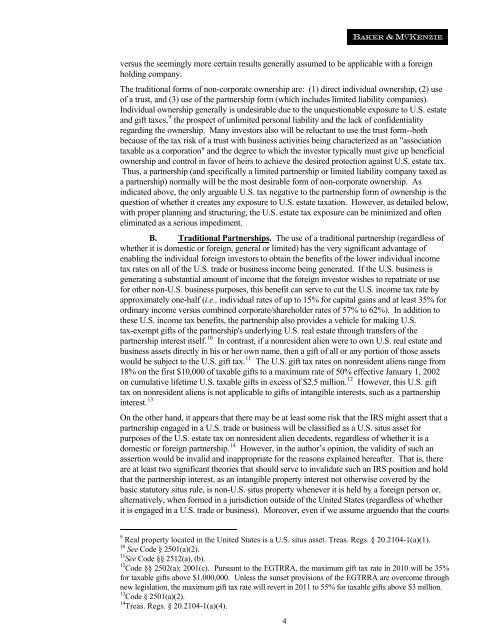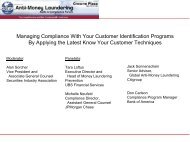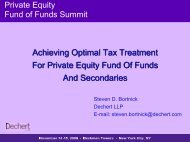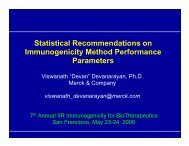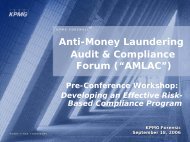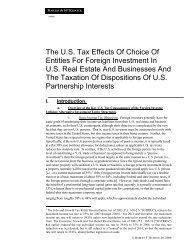The US Tax Effects Of Choice Of Entities For Foreign Investment - IIR
The US Tax Effects Of Choice Of Entities For Foreign Investment - IIR
The US Tax Effects Of Choice Of Entities For Foreign Investment - IIR
You also want an ePaper? Increase the reach of your titles
YUMPU automatically turns print PDFs into web optimized ePapers that Google loves.
versus the seemingly more certain results generally assumed to be applicable with a foreign<br />
holding company.<br />
<strong>The</strong> traditional forms of non-corporate ownership are: (1) direct individual ownership, (2) use<br />
of a trust, and (3) use of the partnership form (which includes limited liability companies).<br />
Individual ownership generally is undesirable due to the unquestionable exposure to U.S. estate<br />
and gift taxes, 9 the prospect of unlimited personal liability and the lack of confidentiality<br />
regarding the ownership. Many investors also will be reluctant to use the trust form--both<br />
because of the tax risk of a trust with business activities being characterized as an "association<br />
taxable as a corporation" and the degree to which the investor typically must give up beneficial<br />
ownership and control in favor of heirs to achieve the desired protection against U.S. estate tax.<br />
Thus, a partnership (and specifically a limited partnership or limited liability company taxed as<br />
a partnership) normally will be the most desirable form of non-corporate ownership. As<br />
indicated above, the only arguable U.S. tax negative to the partnership form of ownership is the<br />
question of whether it creates any exposure to U.S. estate taxation. However, as detailed below,<br />
with proper planning and structuring, the U.S. estate tax exposure can be minimized and often<br />
eliminated as a serious impediment.<br />
B. Traditional Partnerships. <strong>The</strong> use of a traditional partnership (regardless of<br />
whether it is domestic or foreign, general or limited) has the very significant advantage of<br />
enabling the individual foreign investors to obtain the benefits of the lower individual income<br />
tax rates on all of the U.S. trade or business income being generated. If the U.S. business is<br />
generating a substantial amount of income that the foreign investor wishes to repatriate or use<br />
for other non-U.S. business purposes, this benefit can serve to cut the U.S. income tax rate by<br />
approximately one-half (i.e., individual rates of up to 15% for capital gains and at least 35% for<br />
ordinary income versus combined corporate/shareholder rates of 57% to 62%). In addition to<br />
these U.S. income tax benefits, the partnership also provides a vehicle for making U.S.<br />
tax-exempt gifts of the partnership's underlying U.S. real estate through transfers of the<br />
partnership interest itself. 10 In contrast, if a nonresident alien were to own U.S. real estate and<br />
business assets directly in his or her own name, then a gift of all or any portion of those assets<br />
would be subject to the U.S. gift tax. 11 <strong>The</strong> U.S. gift tax rates on nonresident aliens range from<br />
18% on the first $10,000 of taxable gifts to a maximum rate of 50% effective January 1, 2002<br />
on cumulative lifetime U.S. taxable gifts in excess of $2.5 million. 12 However, this U.S. gift<br />
tax on nonresident aliens is not applicable to gifts of intangible interests, such as a partnership<br />
interest. 13<br />
On the other hand, it appears that there may be at least some risk that the IRS might assert that a<br />
partnership engaged in a U.S. trade or business will be classified as a U.S. situs asset for<br />
purposes of the U.S. estate tax on nonresident alien decedents, regardless of whether it is a<br />
domestic or foreign partnership. 14 However, in the author’s opinion, the validity of such an<br />
assertion would be invalid and inappropriate for the reasons explained hereafter. That is, there<br />
are at least two significant theories that should serve to invalidate such an IRS position and hold<br />
that the partnership interest, as an intangible property interest not otherwise covered by the<br />
basic statutory situs rule, is non-U.S. situs property whenever it is held by a foreign person or,<br />
alternatively, when formed in a jurisdiction outside of the United States (regardless of whether<br />
it is engaged in a U.S. trade or business). Moreover, even if we assume arguendo that the courts<br />
9 Real property located in the United States is a U.S. situs asset. Treas. Regs. § 20.2104-1(a)(1).<br />
10 See Code § 2501(a)(2).<br />
11 See Code §§ 2512(a), (b).<br />
12 Code §§ 2502(a); 2001(c). Pursuant to the EGTRRA, the maximum gift tax rate in 2010 will be 35%<br />
for taxable gifts above $1,000,000. Unless the sunset provisions of the EGTRRA are overcome through<br />
new legislation, the maximum gift tax rate will revert in 2011 to 55% for taxable gifts above $3 million.<br />
13 Code § 2501(a)(2).<br />
14 Treas. Regs. § 20.2104-1(a)(4).<br />
4


